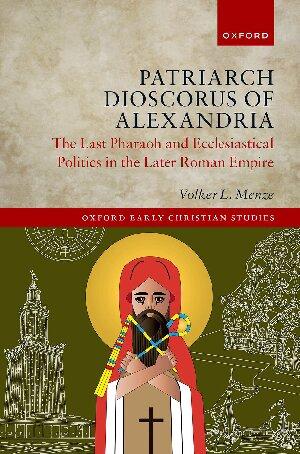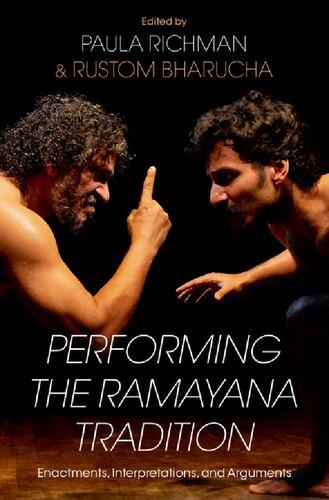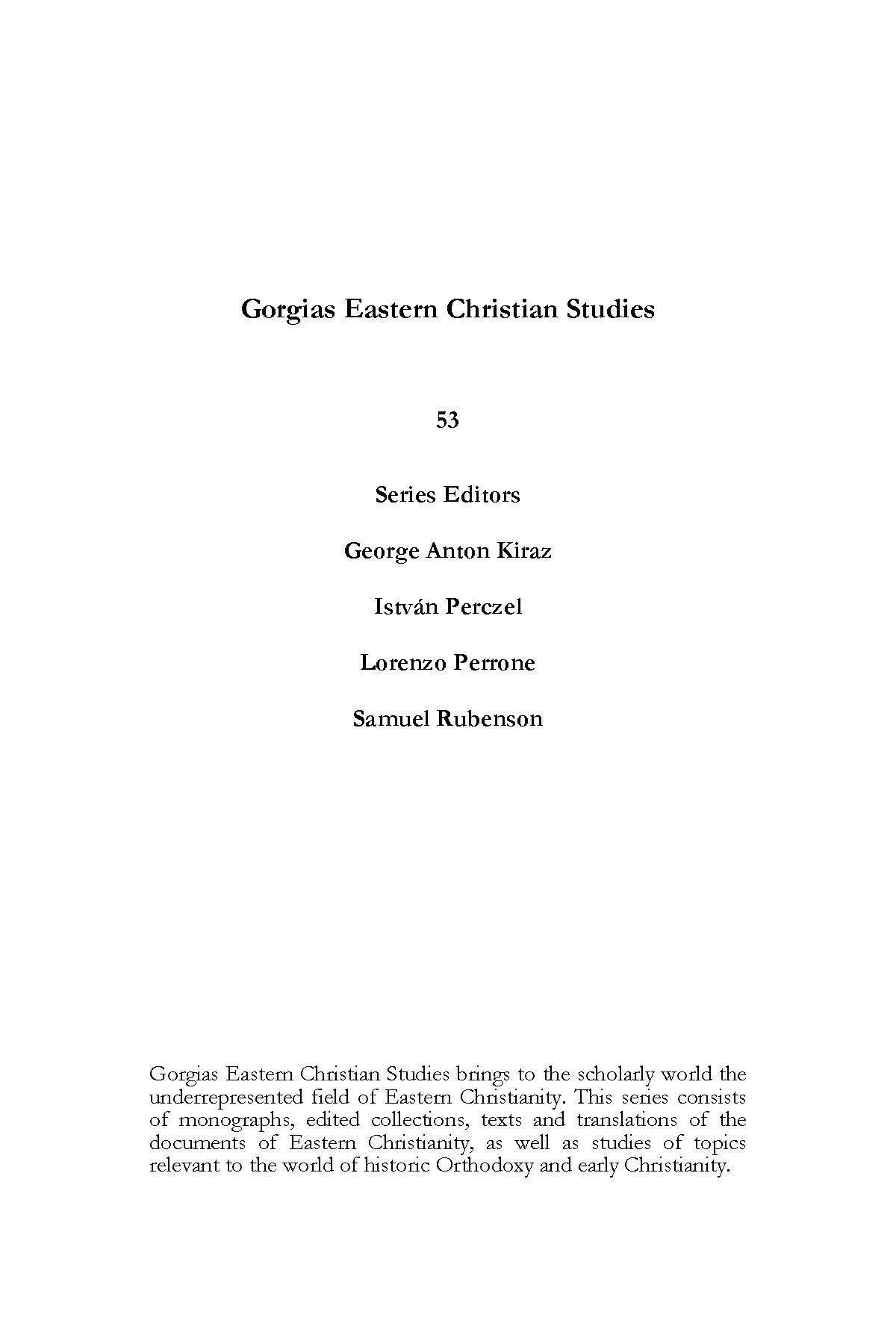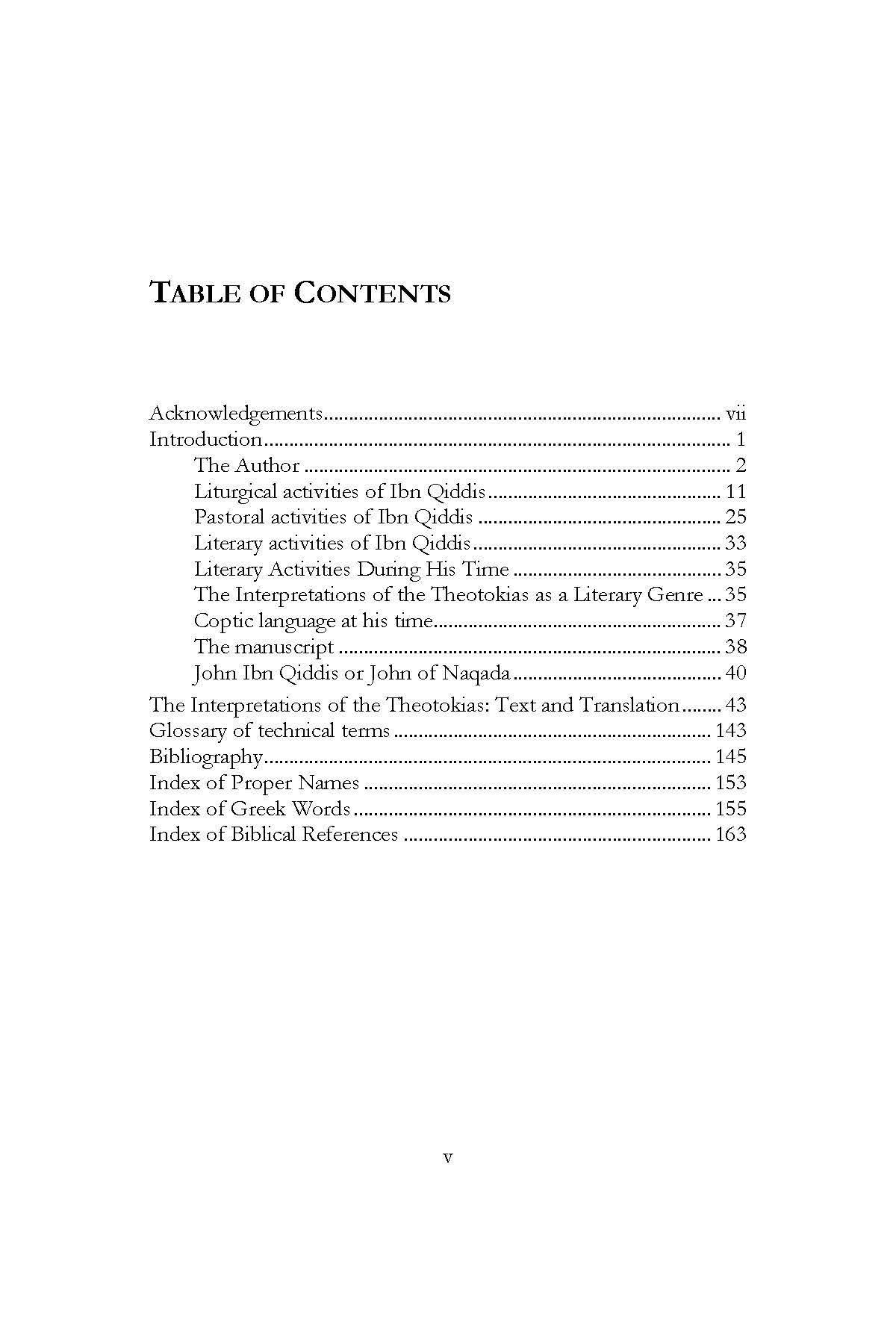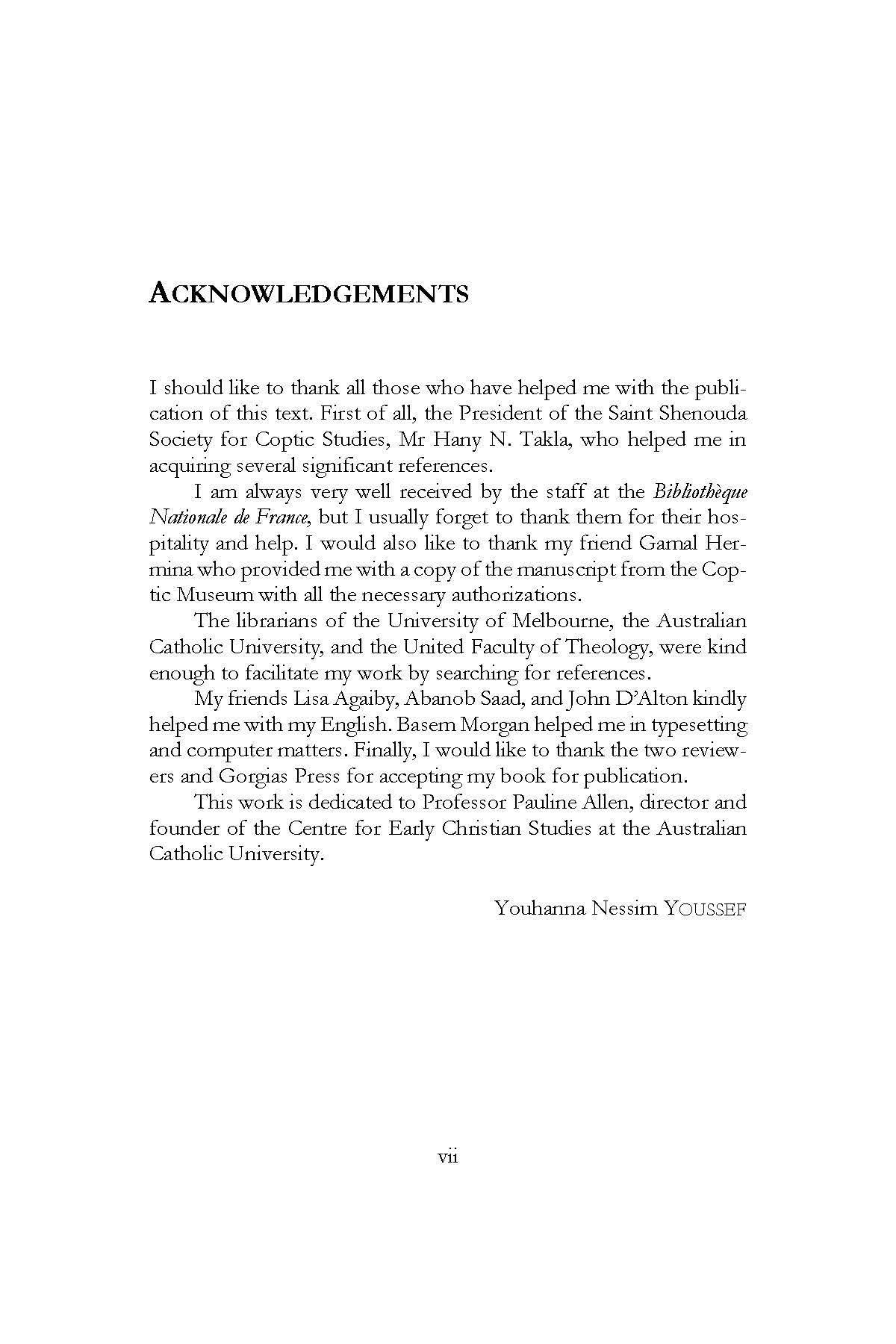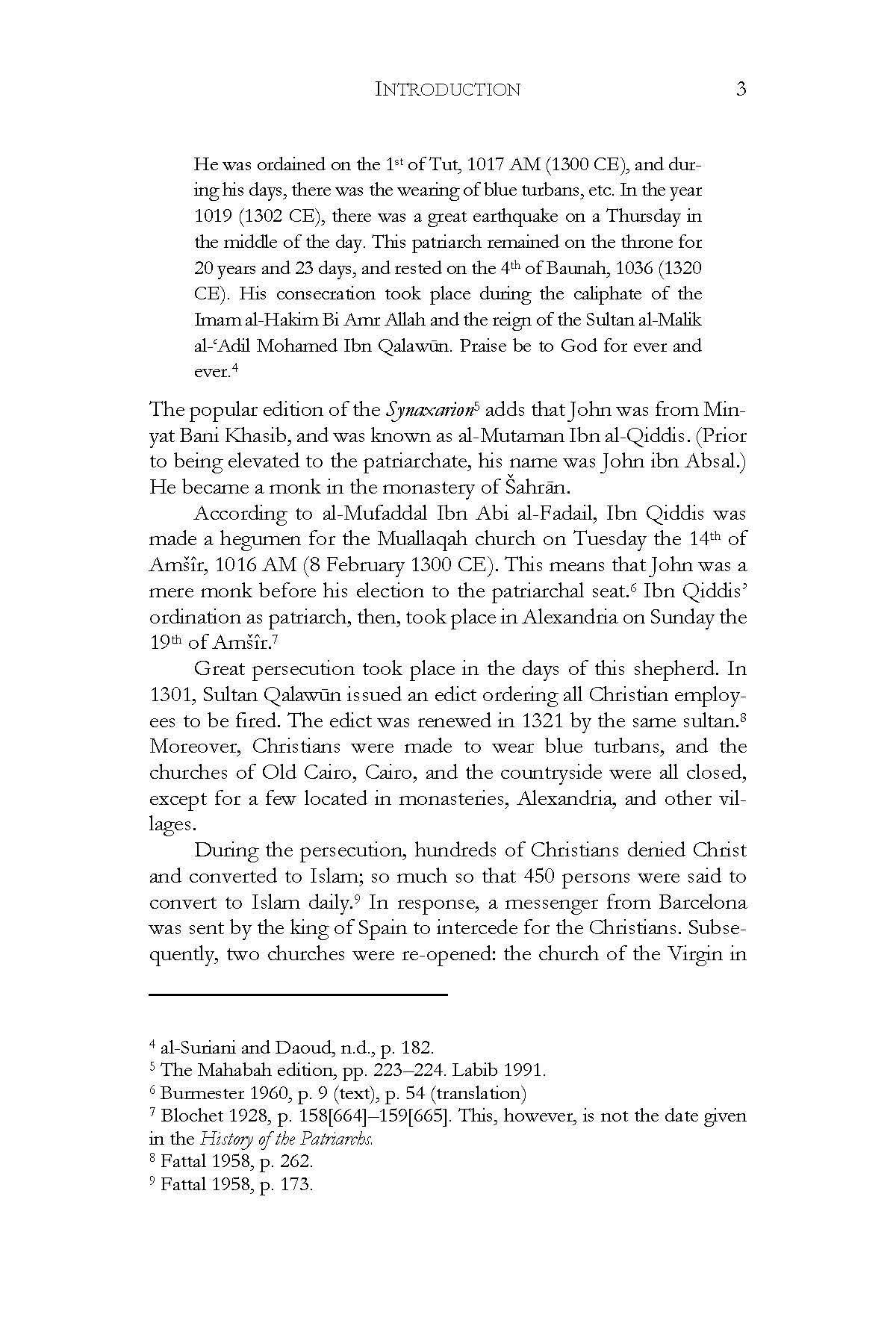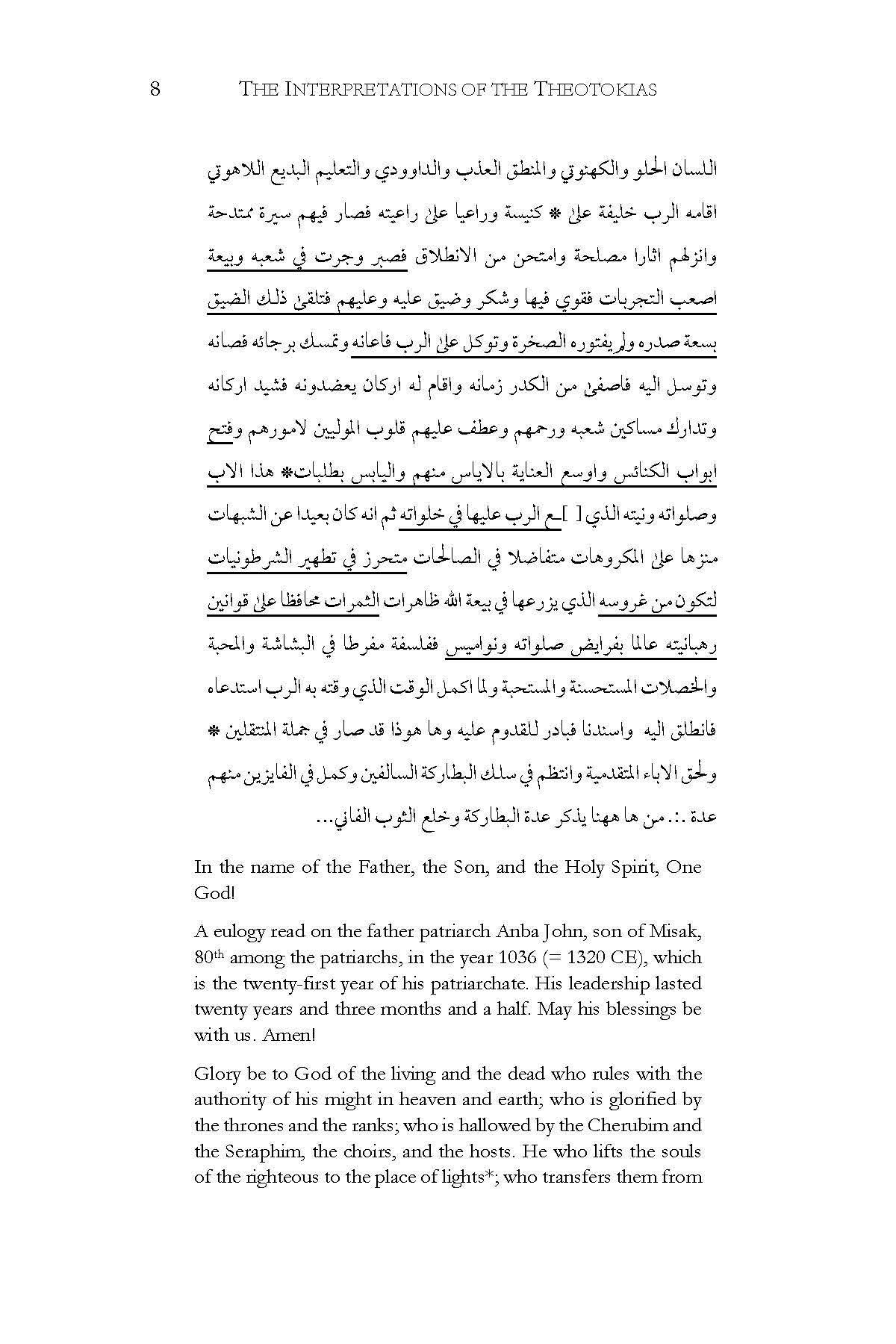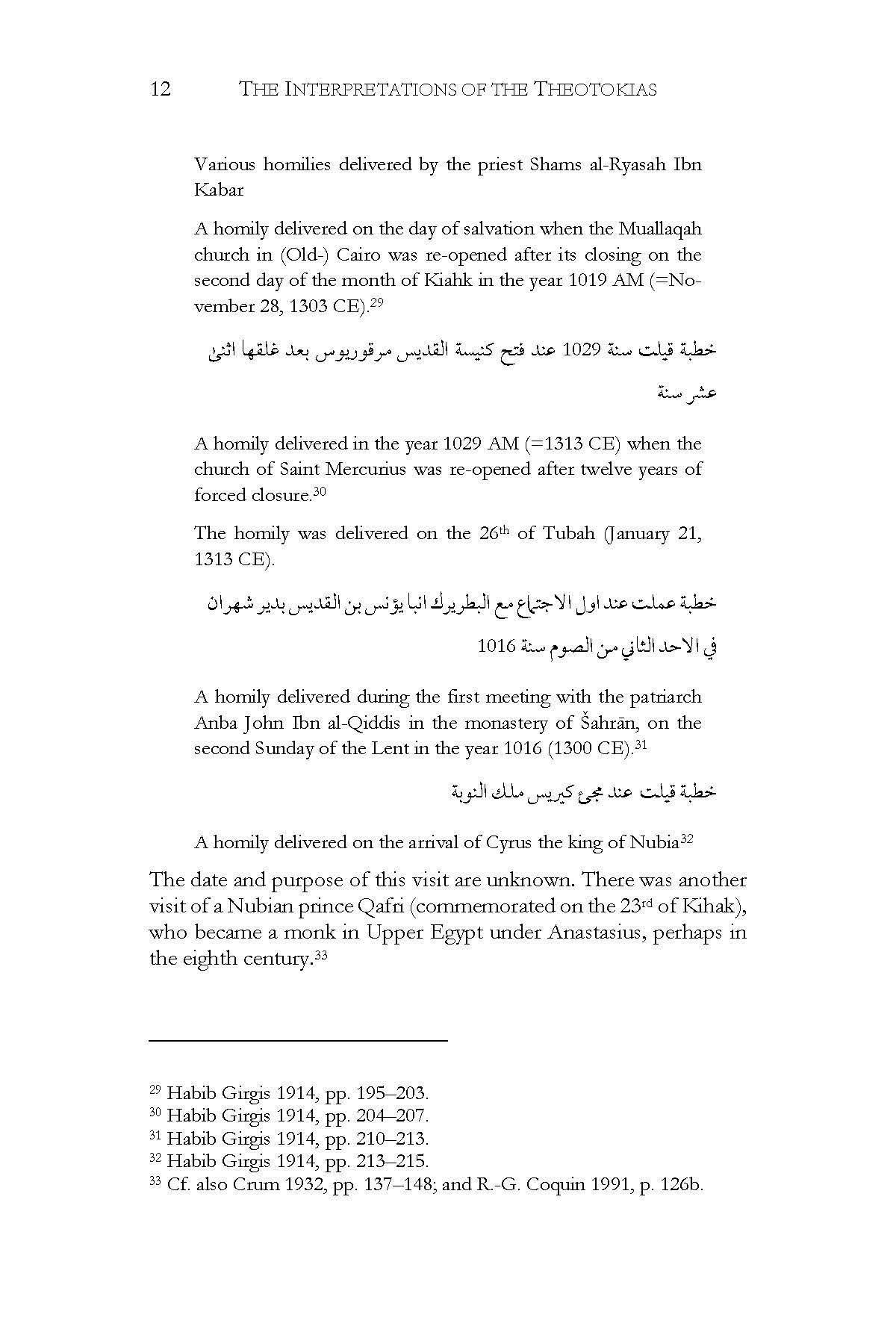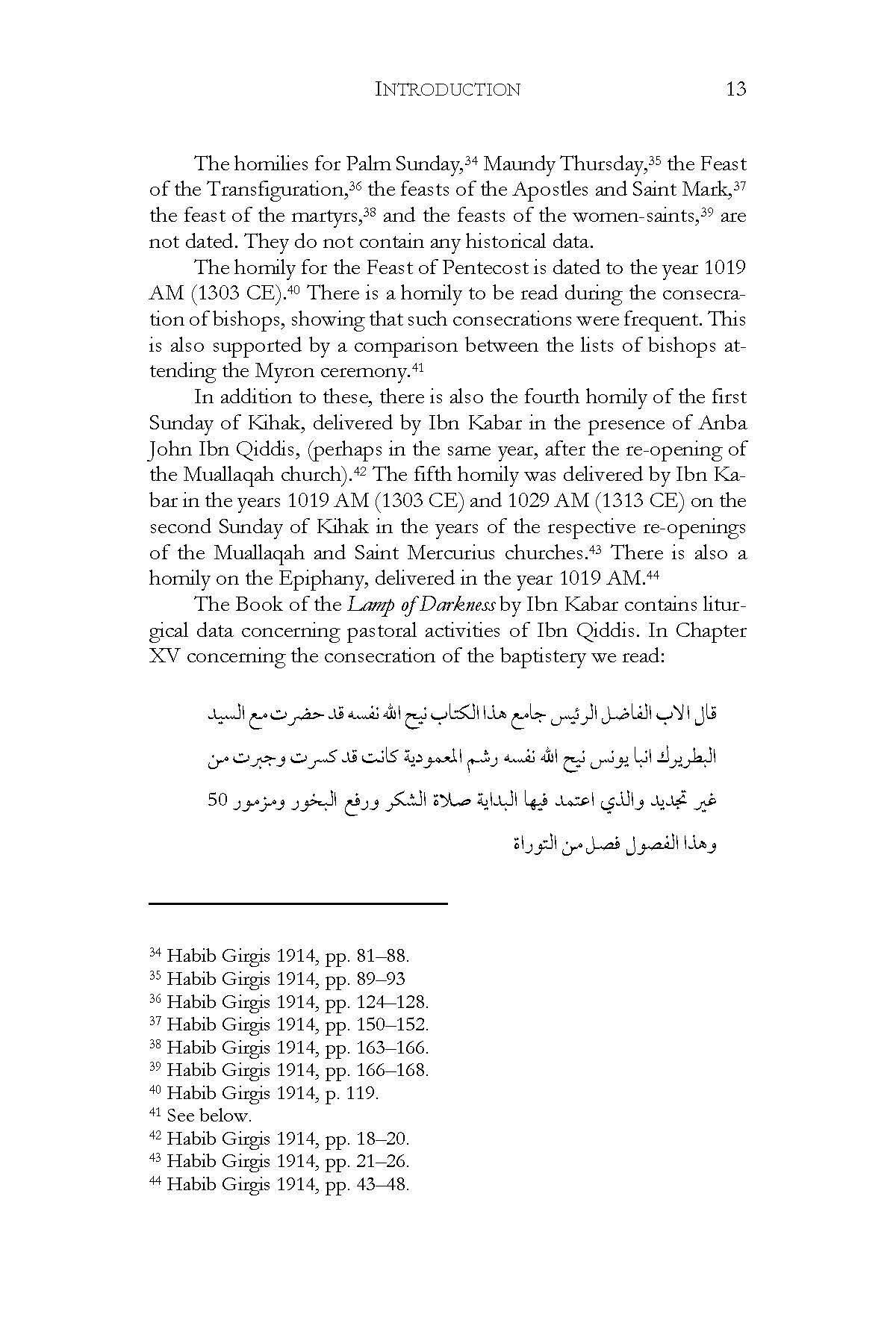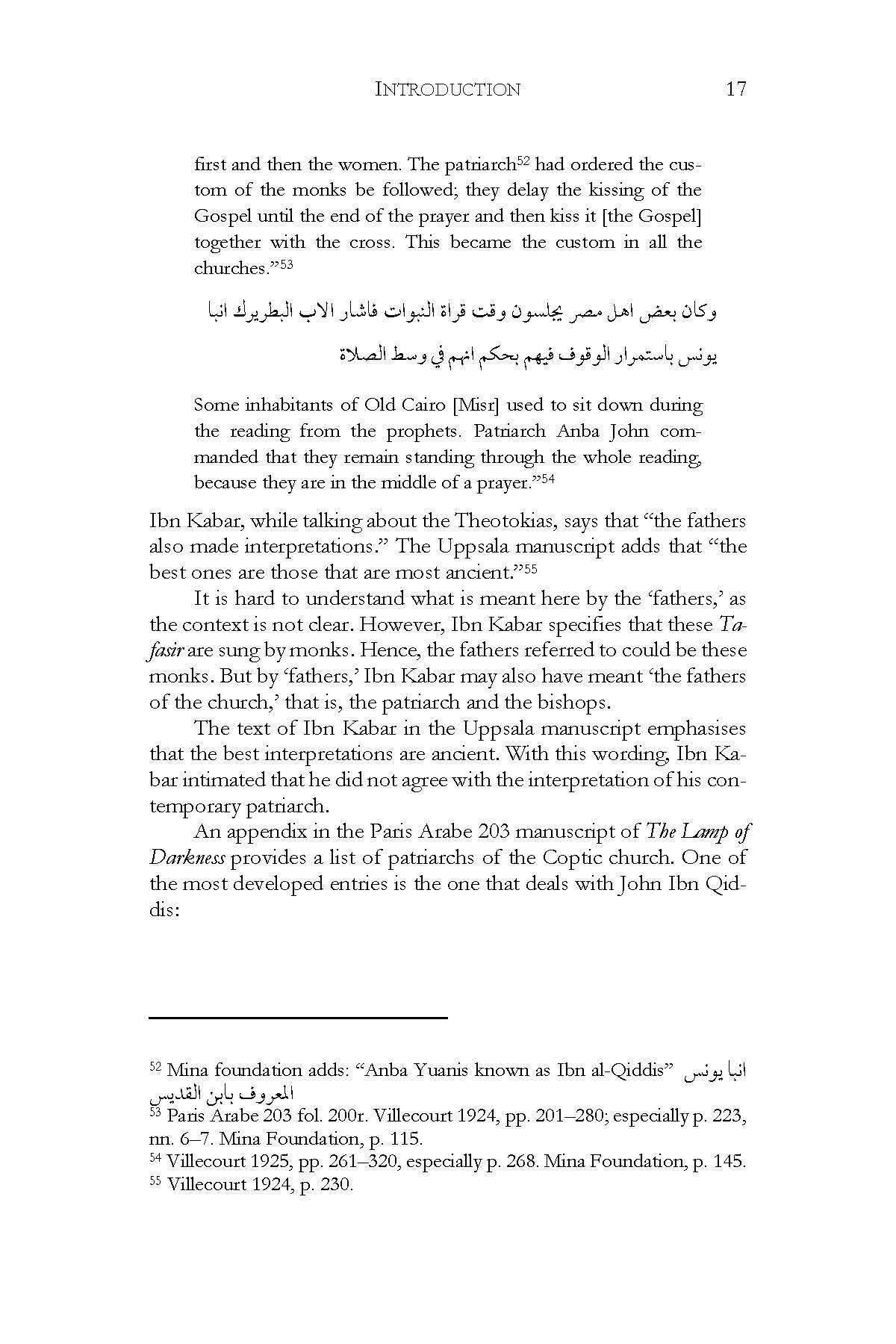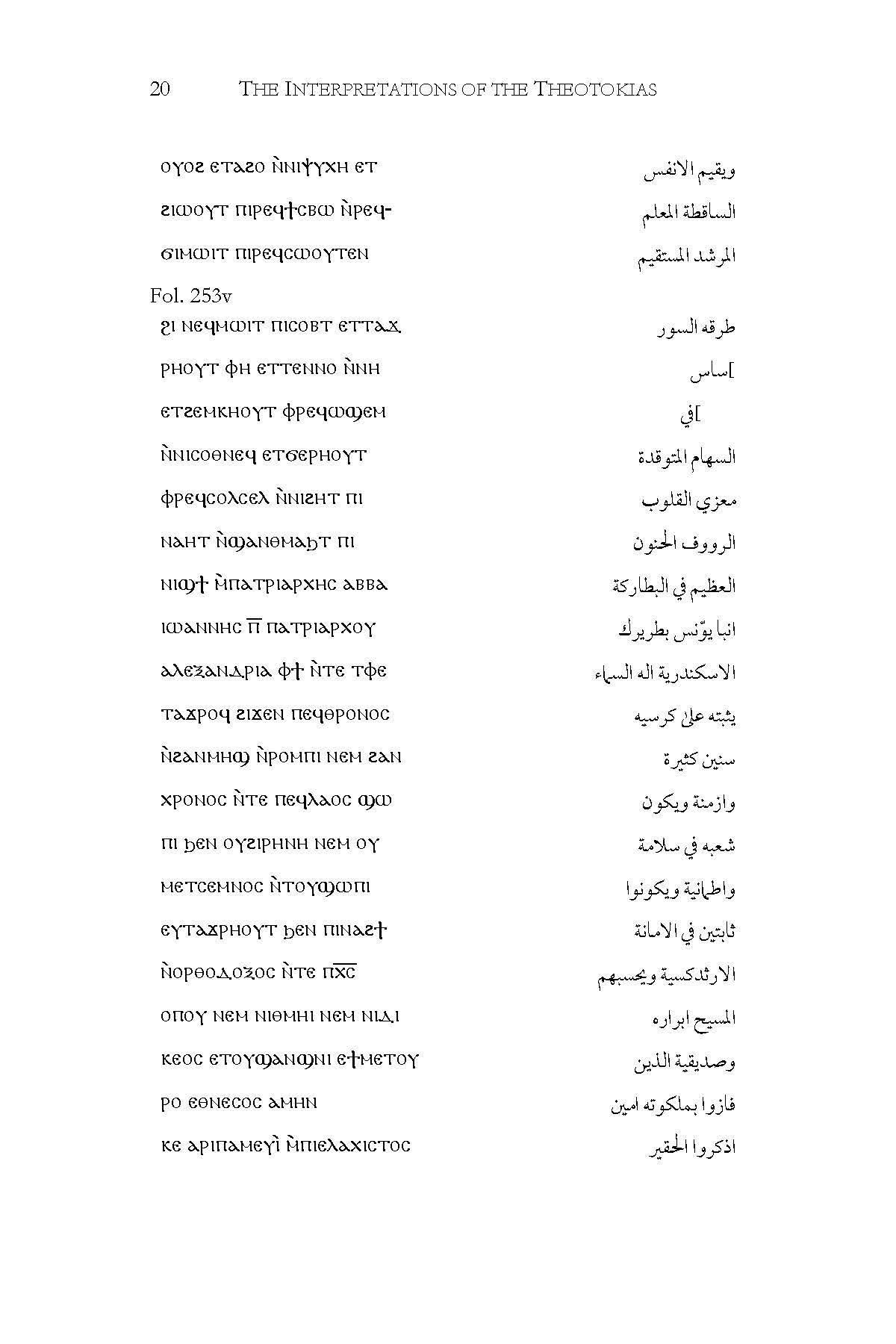The Interpretations of the Theotokias by the
Patriarch John Ibn Qiddis
Nessim Youssef
Youhanna
Gorgias Press LLC, 954 River Road, Piscataway, NJ, 08854, USA
www.gorgiaspress.com
Copyright© 2020 by Gorgias Press LLC
All rights reserved under International and Pan-American Copyright Conventions. No part of this publication may be reproduced, stored in a retrieval syst= or transmitted in any form or by any means, electronic, mechanical, photocopying, recording, scanning or otherwise without the prior written permission of Gorgias Press LLC.
2020
ISBN 978-1-4632-3948-0
ISSN 1539-1507
Library of Congress Cataloging-in-Publication Data
A Ca ta l o g i ng -in- Pub li c a t io n Record i s a v a i la b l e from the Library o f Con gress
Printed in the United States of America
ACKNOWLEDGEMENTS
I should like to thank all those who have helped me with the publication of this text. First of all, the President of the Saint Shenouda Society for Coptic Studies, Mr Hany N. Takla, who helped me in acquiring several significant references.
I am always very well received by the staff at the Bibliotheque Nationafe de France, but I usually forget to thank them for their h ospitality and help. I would also like to thank my friend Gamal Hermina who provided me with a copy of the manuscript from the Coptic Museum with all the necessary authorizations.
The librarians of the University of Melbourne, the Australian Catholic University, and th e United Faculty of Theology, were kind enough to facilitate my work by searching for references.
My friends LisaAgaiby, Abanob Saad, and John D'Alton kindly help ed m e with my English. Basem M o rgan helped m e in typesetting and compute r matters. Finally, I would like to thank th e two r eviewers and Gorgias Pres s for accepting my book for publication.
This work is dedicated to Professor Pauline Allen, director and founder of the Centre for Early Christian Studies at the Australian Catholic University.
Youhanna Nessim Y OUSSEF
INTRODUCTION
Coptic history, especially of the early fourteenth century, is like a puzzle for which we do not possess all the pieces. In what follows, I will give an overview of relevant sources and their various interpretations. The sources can be classified under the following headings:
a - Coptic Sources: Our main sources are the Book efthe History efthe Patriarchs, ascribed to Ibn al-Muqqafa, as well a s the Patriarchal History, attributed to Yusab, bishop of Fuwwah. The Synaxarion can be cons idered a good source of informatio n, and secular sources provide historical context for the events. Many of these sources paint an image ofJohn Ibn Qiddis as a beloved patriarch of the Coptic church, and his eulogy was still being transcribed after centuries of his death.
b- Islamic Sources: Valuable information is found in Islamic sources contained in the History efthe Mamfuk Sultans by alMufaddal Ibn Abi al -Fadail.
c- Liturgical sources: In addition to th ese historical sources, we have ones describing the liturgical activities of Ibn Qiddis and his contemporary, Ibn Kabar. These shed additional light on Ibn Qiddis and his Interpretations efthe Theotokias.
d- Manuscript colophons: The colophon of th e Mingana Arabic 61 Coptic 2 manuscript provides important information about Ibn Qiddis' time. Further information is found in the Coptic Museum Biblica 12 manuscript. According to the latter, John Ibn Qiddis was known as al-Mu'tamin and he copied the book ofisaiah.
e - A manuscript on the Consecration of Myron: The Pari s National Library MS Arabe 100 gives an account of two Holy Myron consecration ceremonies performed by Ibn Qiddis. Thi s manuscript also lists the participating bishops and their 1
dioceses. It thus sheds light on the pastoral activities of Ibn Qiddis as well as on the creation of new dioceses and disappearance of old ones.
f- Contemporary Copto-Arabic literature: Knowledge of Christian literary activity in the late thirteenth and early fourteenth century Egypt adds another piece to the puzzle.
All these axes of research contribute to our understanding of Ibn Qiddis' main work that is published in the present book. We will discuss each of these axes in detail in order to give the reader a fuller understanding of the author and his work.
THE AUTHOR
The brief, anonymous 1 chapter on the life of John VIII in the Book ofthe History ofthe Patriarchs, ascribed to Ibn al-Muqqafa, gives mere few details about John's patriarchate. He was the eightieth patriarch (1300-1320), known as Ibn Qiddis. In his day, Christians were forced to wear blue turbans, and a great earthquake took place. Ibn Qiddis also attended the funeral service of father Barsuma the Naked.2
The History of the Patriarchs, 3 attributed to Yusab, bishop of Fuwwah, has this to say:
.!.l__r._,1)1 ~..WI er.I~ y. l}I r-,l--JI vl,I J 0ls_., i+l] P, u..11 L -::.,.,y J_.,I i..\i ~Ii y.P, ~__, u..11 L ~~)j~..l>- _., cl~i f.11:" L._.,J J) I
:..r..P.J ~.J L :..r..P '-,?,;:JI~ '--:-NI i..i.A, il;i_., J~I :i;~ J .:....\Z -:..;ls_.,~_., :i:.... ..;Ji L :z.;Y. :.r,- iY. (;IJ CfS.J ½-½I l:;b 4 r::-11_., 0_.,_.,)'u er.I~ 0lh.Lll o:.lt J 41 r½ r5LJ..1 iL.'11
The patriarch Anba Yuanis lbn al-Qiddis, the eightieth.
1 Den Heijer 1989, p 145.
2 I<Gi.ater and Burmeste r 1970, pp. 134-135 (text), p. 231 (translation)
3 For this book, cf. Moawad 2006, pp. 255-270.
He was ordained on the 1s t of Tut, 1017 AM (1300 CE ), and during his days, there was the wearing of blue turbans, etc. In the y ear 1019 (1302 CE), there was a great earthquake on a Thursday in the middle of the day. This patriarch remained on the throne for 20 years and 23 days, and rested on the 4 th ofBaunah, 1036 (1320 CE). His consecration took place during the caliphate of the Imam al-Hakim Bi Amr Allah and the reign of the Sultan al-Malik al-'Adil Mohamed Ibn Qalawun. Praise be to God for ever and ever. 4
The popular edition of th e Synaxarion5 adds that J o hn was from Minyat Bani Khasib, and was known as al- Mutaman lbn al-Qiddi s . (Prior to b eing elevate d to the patriarchate, his name was John ibn Abs al. ) He became a monk in the monastery o f Sahran. According to al-Mufaddal lbn Abi al-Fadail, lbn Qiddis was made a hegumen for the Muallaqah church o n Tuesday th e 14th of Amsir, 1016 AM (8 February 1300 CE) This means that John was a mere monk before his election to the patriarchal seat.6 lbn Qiddis' ordination as patriarch, the n, took place in Al exandria o n Sunday th e 19 th of Amsir.7
Gre at p ers ecution took place in th e days of this sheph e rd. In 1301, Sultan Qalawun i s sued an edict o rde ring all Chri s tian emp lo yees to be fired. The edict was renewed in 1321 by the same sultan. 8 Moreover, Christians w ere made to w ear blue turbans, and th e churches of Old Cairo, Cairo, and the countryside were all closed, except for a few located in mon asteries, Ale xandri a, and o ther villages.
During the p ers ecution, hundreds o f Chri stians d enied Chri st and conve rte d to I slam; so much so that 450 p e rsons we r e said to con vert to Islam d aily. 9 In res p onse, a m essenger fr o m B arcelona was sent by the king of Spain to inte rc ed e for th e C hristians. Sub seq u ently, two chu rc h es were r e -o p e n ed: th e church of the V i rgi n in
4 al-S uriani and Daoud, n.d., p. 1 8 2.
5 The Mahabah e dition, pp. 223-224. Labib 19 91.
6 Burmes te r 1960, p . 9 (text), p. 54 (translation)
7 B loche t 1 928, p 15 8 [664) - 15 9 [665). This, howev er, is n ot the d a te giv en in the History of the Patrian:hs
8 Fattal 19 58, p. 262.
9 Fattal 19 58, p. 173.
Harit Zuwaylah and the Melkite church of St. Nicholas at Harnmam al-Akhawayn. 10 The church of Harit al-Rwn remained closed for eleven years and was re-opened on the 23 rd of Tut, 1311 CE. 11 Ibn Qiddis was the last patriarch to dwell in the church of Abu Seifen in Old Cairo, and it was he who transferred the throne to the church of Harit Zuwaylah. 12 Ibn Qiddis resided in this church from 1303 CE onwards, when a great earthquake occurred and destroyed many parts of Syria and Egypt. Ibn Kabar mentions that the patriarch made modifications to the liturgy (the Eucharist). It was also during the reign of Ibn Qiddis that Saint Barswna, known as "the Naked" (Bin al-Tabban), died. The patriarch prayed over him on th e 5th of Nasi, 1021 AM.
According to Symon Semeonis (1322- 1324 CE), churches w er e forced t o clo se in 1320. The closure laste d for thr ee years and ended the year Ibn Qiddis died.13
Islamic sources mention that John ' s election and consecration as patriarch took place during the second reign of al-Nasir Muhammad (1299-1309 CE) and that it was quietly performed without opposition. The patriarchate ofJ ohn Ibn Qiddis succeed ed that o f Theodosius II (1294-1 300).14 Theodosius II seems to h ave been unpopular, and unr est b egan to manifest during his brief re ign. This unr e st is refl e cted in a h o mily d elivere d by I bn Kab ar o n the occasion o f a meeting with the patriarch.15
J o h n Ib n Qiddis w a s als o a c ontemporary o f B aybar s-J as hankir (1309-1310), who was followed by al-Nasir in his third reign ( 13101341). During this period, the Copts suffered from a setback due to restrictions o n their freedom imposed by a Maghribi vizier. On his way to Mecca for a Muslim pilgrimage, the vizier passed through
10 The emperor of Cons tantinopl e also tri ed to intercede for the Chris tian s in Egypt, Blochet 192 8, P- 195(701). It is noteworthy to mention that the church of the C rucifixion in Jerusalem was d es troy ed and b ecame a mo s que.
11 Forget 1963, P- 37
12 R.-G_ Coquin 19 916; Blochet 1928, pp. 38(544)-40(546), 67[573)7 3 [579] , 9 5[6 01)- 9 2( 602).
13 C C oqui n 1974, p. 9 5 .
14 Labib 1991, pp. 2241-22 42. 1s Habib Girgis 19 14, pp. 207-209.
Cairo.16 'While riding in the city, he noticed a well-dressed person on horseback. with poor folk surrounding him, asking for favours. \Xlhen the vizier inquired about the dignitary, he was infuriated to learn that the individual was a Coptic Christian. The vizier went to al-Nasir and his viceroy, Salar, to protest that "infidel" Christians could occupy such high positions. As a result, the Copts suffered from the enforcement of antiquated and humiliating decrees. They were ordered to wear blue turbans and girdles and to ride donkeys instead of horses. In a similar vein, Jews were required to wear yellow turbans. The patriarch and the chief rabbi were swnmoned to the court and both were ordered to enforce these regulations in their respective congregations. The Maghribi vizier also tried to convince the local authorities to d es troy churche s, but his attempts fail e d because the chief justice issued a special juridical verdict (fatwa) . According to the verdict, the Covenant of 'Umar had specified that only newly built churches could be demolished, whereas older o nes had to be protected. The chief justice in question was Taqi al-Din Muhammad ibn Daqiq al-'Abd, a Muslim whose ancestors were Islamized Copts.17 Yet the verdict did not stop a Muslim mob from mountin g frequent attacks on the churches.
In 1303 CE, Baybars abolished th e custom of c elebrating th e relics of J ohn of Sanhut.18 According to Maqrizi, all c hurch e s wer e again closed in 1316 CE and only the Muallaqah church was reope n ed two months later.19
John Ibo Qiddis was one of the most beloved patriarchs in the Coptic church. His eulogy, which was still being transcribed centuries after his death,20 depicts the patriarch as a saint.
Here i s the colophon:
16 El-Leithy 2006, pp. 106-108.
17 Quatremer e 1845, Vol. 2, pp. 179- 180.
18 Meinardus 1970, p 172, Viaud 1979, p 10 L utfi 1998, pp. 254-281
19 C. Coquin 1974, p. 68.
2°Cf. Abd El Shahid 2005, pp. 71-72, Number 425 (6509).
u::--1 ½.-½ I i.cb .& ~I_., t...;,..WI .!ly.~ I oJ i+l] b.. ye L ?.s.r-- Z l)
Remember the poor, humble scribe, Girgis (George ), originally from Behnasa and now dwelling in (the church) of Abu Seifen. The humble Girgis, the disciple of hegurnen Barsum, the minister of Abu Seifen, ~ocated) in the street of the river2 1 in the lane of the patriarch in l\fisr al-Qaclimah (Old Cairo). Thanks be to God for ever and ever, Amen!
On the 7 th of the month ofl'vf:isra, in the year 1409 of the martyrs (= 1693 CE).
And here is the text of the eulogy itself: -.l>-1_.,JI .J'Ji <.Y'..WI c_.J).J c:r.'JI_., '-:-''JI r, -0}h)I J u:,ii_.!li .!l~c:r.l c_.rily. ~i .!ly.~I '-:-''JI&,"~};_;.r'
J J-..5 ..li_., 6 y.~ ,:y., w_.,~1_., ~~lJ..1 WI ,:_y., w..11_., .:,.;">U_., LL u::--1 ~wfa .;ls.1. ~.,~I~., L w_.,..r-9 Ll,.)1
c/J 'JI_., ul.,.._.jl J ..;J..li w~ J ~I ul_.,..'JI_., .~'JI.Ji.& ~I ~IJLJI_., ~.JJ~I ,:_y., <.Y'..illl -::.,µkll_., --,,Jl)I_., '-#"1.,sJI ,:_y., ~ I Jl_.,)IJ~ ,:_y., ~Li_.,*J_,:JI J-,! cll ).1.'JI <.Y'_y,j ~IJ ui_,...JI_., J __,..;..,,,JI_.,
JK;'Ji & µ 'J '-?l.ll J ~~Ldl .~1_.,..LJ,Y--' J;::.,,'Jlj~ cll
J ~I .J -J~~'JI_., ~½'JI cll ..:;..,l}~½ ~..ul I~ J ..:;..,~WI ,y Y--.J ~J w~ wl .r --5.lll-½>- _.,Ji ~'J_., Jk.., 'JI_., JL.'JI_., ..:;..,l;_.,'JI_., Li'JI &, l:J ~_.,):,,JI u-1Y. J,.WI __,k.,JI wU Jl; 1.,5 ofa.11 ul~I J½>°I ~'-?;,JI .h).i).)1 ......,..li c_.J).J J½>°I L.,.J.JJ.J;:;_.,..~ J½>°I J l!..
21 Lit. " the sea."
22 Read: ..:.-,}
L..WI '-?lll.J LJls *Jl+b'JI <l...,.,J &, ~l,.. .J) ~1). 1 1L..... r-r. L,.J.JJ.J ~ ip:lls :..r....J::'"" ~I 1l;i.J 4----fo J ,i_..JI JW
tl.,;.JI.J ~l.,;.JI '-:-"-:!~ l; ,ye.J 4dJ Cl.h;.J 4--l.h; J J-S.J 4----.,.._..t 1 ,. , I .J l.::..!_,. I -LL,._ 1 • , I Li :W,,lli ...;L...1...] L;1 1 ~\; - .J ~'<"' - ? i .J_~_ .• _ ~I ~.J)I J ......tl:5 0y .I- :..,:.,r...Lo.J ~~.J W>lJ.i y~..ul :.r~..U,'Ji tiJ.h.,J :u;J1 ?.s.J.h ?,s_raJ1 ..;11 .µ1 ~)y r~J Y ..J ._;:.:s <?I 4::9~1 ~.J~'J½ r-r..Jl-.½.J ~I ?,s_,..JI *..L.!.; .)1 :J.Ldi
yi:J I
J>- •~:-:, y )I :.r-~ 0~.J ...w y, l.,..J ~'J I ~ I}
~l.h,Ji.J ll.;.l..i.ll ~1}1 ~l;i ;..,.~ :.r- 0~..J ~l.k.ii blu
J-S 1:-:,1 ,')LJ1.J &di 0 ~ .J ;..,.l.k..,½ J-,L1 0 ~ ..J
J~'J I :.r- ~_;....) ~I <..l".J~} d i y)I ...u;.J r'-l>-1 ..:.b½-0 ~10 1~J ~'-?lll •..::..i.,JI J J l.:;'Ji-!.LL½~..J ~.JJKJI &, ~ \.{.I :t;~.J .,;.,~l)~l; ~ls ;:;.Jl.h,. J .J o~I.J w,...L;Ji .).~I .llJ-½ 'J .J o_,Ayl ...,.K,..1 -l>-1 J.J .,;.,~I d i fa..J
~IJ~I y, 1~-JI .,;.,..IP .)1 :z.a½ .Jy-o--.Jl_-91 JS.J o~ I J#I y, ),r.'JI 0.,....,.w1 •½ 'J I.J J l:> 'JI L,.J.J)I .~UI lr,I ..i;.J •.r"'L; .~'J)I :.r-:..r..~)}1 :i.)y)I w\.{.141 ~I._;,. Jl+b'JI l;.>'JI 0)\j.l.J
L..li C.JJ J 1.r-½ J l.;i.J ~I fa .J ~all~ ~~.,.._,JI •I.: ;:)WI ~yl ~ ll l j.,-l.s::ll J...,;l..i.ll j.,- WI )WI •y'J I ~ I ~I 0 -J -!.JUL,.J.J)I J.J •½'JI y l ½..r-11 C~.J ~ I r" ~l;J I p'.l l -0).h)I J ~I :.,:.~I 0~'JI cJ"'""[;.:..J 0 y.)~I J-...,)I p J~..ul.J ~~'JI~ ~..Ill .ll.1-~ 0')\; yl ~')Il l .,;.,~ ~ l,.;11
1.J:-:, JI oLl::ll ~1 l .,..J ~p l.J ~I.J ½ JJI ~'>l:]I.J ~.,-d i
IJ_r')iJI 0 -.yi ~I_, '-?~_,..,1.iJ1_, y..WI J.k;ll_, IJ~I_, __,.iJ..1 wL.UI ~..\:..( .--':'""' r-+.:9 Jla; ~IJ & ~IJ_, * & y )I ..,.l;i ~-' 0 J u_?--J J)\.k;'J I :_,,,-~I_,~ 1}11 ~jl_, ~I ~.) e.., J::-.,o.., ~.., '-?? ul:~1 ~I ...;La;~~ ,1. d-..1..,...;~l; y )I & JSY-' .µ1 •J~).., Oj..l.,.:,~ ...;l5) ...;..,..L,a.,,., wl5) .J il;i_, ...;L.j J£.ll y ~l; ..)1 J--.,y _, ~-' t1'JY'J .:r.Jjl y_,l; ~.., r+"'J-' 0 ~L..!.l)_\j..,
y 'JI I~ *u~ <..T""!lJI_, r:f:: er~'J ½l:;Ll l t:::..,1.., c_rSl:5:J I ylY. I .:;.;~I ,y I~ wl5 ...;1 JJI}>- J y )It:[ ] '-?lll 4.., JJl_,.1-_, d.;), _;JI~ J j.r=-- .:;.;U..Ldl J ')l;,L..::.,. d.~..,.,511 & ;-,~I.J-' & lw~d~I d_,.A>IJ;, .&I ~J J..i;'-?lll "--'-'/' :_,,,-0§::l :w..11 UL!..JI . lb . :z..i......Li; I · JJI I - • I . ll ~ c..;~ . -' . y ..;A-' er:-° Y-' .r- c.r'-:-.r'½ •. J .~.x:....,I y )1 '½ ci.., '-?lll-:;.,.;_,JI j..SI ll.., ~I_, ~I .:;.;)ld..l_, * I lli:- J JI.,., ..ti I.)r _, i-'..w..l l;.x.....,I_, ..)1 Jlh;l; ~.:r...i;wl Jj..s..,~LJI c } h:]I dL,J ~I_, ~..Lc.l. l •½'JI c)..., ···i)WI y.fll &-..,c}h)I -~ .?--½ :_,,,-.:. o.lP
In the name of the Father, the Son, and the Holy Spirit, One G od!
A eulogy rea d on the father p a triarch Anb a John, s o n of IVl:isak, 80 th among the patriarchs, in the year 1036 (= 1320 CE) , which is the twenty-first year of his patriarchate. His leadership lasted twen ty years and three months and a half. May his blessings be with us. Amen!
Glory b e to God of the living and the dead who rules with th e authority of his might in h eav e n and ea rth; who is glorified by the th rones and the ranks; who is hallowe d b y th e Cherubim and the Seraphim, the choirs, and the hosts. He who lifts the souls of the right eous to the place of lights*; who transfe rs them from
the perishable world to the world of stability; granting the world according to his true promises in that paradise that no mind had imagined, 23 rewarding them instead of the world from the perishable of this age to the remaining (things) for ages and generations. To him is the glory both now and ever, from the sunset to the dawns, with His Unique Son who is the high priest of the good things to come, 24 as the tongue of the sublime perfume, Paul the chosen one, has said. He established for us, according to his rank, priests that minister to Him, and high priests to His Holy Spirit the Paraclete and the comforter, who distributes the spiritual gifts over His pure Apostles* as tongues. He made His holy church as a type of heaven in its ranks. He established priests shining like stars and their leaders like their suns. He perfected the arrangement of its structure, as well as the structure of its arrangement he adorned the discipline of its condition and the condition of its discipline.
He instituted, for His rational flocks, an awaking guard for their protection, surrounding and confirming them so as to safeguard them to preserve them from the pouncing wolves, and restoring them. And [He established] leaders to pasture his flock to the green pastures and by the water of life, he reared them2 5 which safeguarding them from harm and watered the crops and prepared them as goodly food that will fortify the weakened forced, treat them with the healing medications which cure the sick souls and make them return, by what they took from our Lord-to Him is the Glory- and His Apostles. And by what he ordered them with the Apostolic canons and what we should do and what beseech from the Lord- may his mention b e elevated---on their behalf-to loosen the bonds of the sins, and they ask for them from His generosity which overflowed from the good gifts and grants explaining the word with straightforwardness and in consolation and peace. Then, when he accomplished his straight race, the Lord transferred him to the paradise ofJoy to rest from the heavy weight he had carried and enjoy by

23 1 Cor 2:9
24 Heb 9:11.
25 P s 22[23] 2.
that transfer in the time that our Lord knows. As the one who knows the hidden things-may He be blessed-who sits on the Cherubim and looks towards the lowly-the traces of whose sublime judgements no one can follow; no one can comprehend the mysterious consequences that are beyond enlightened minds, and all his deeds are full of wisdom, which is above understanding.
You are aware, 0 masters, the chosen leaders, the holy righteous fathers, and beloved pure friends, the sons of the church of the universal A postolic church, who are born from the sublime birth from the water of the baptism-the news of God (regarding) your orphan state and-let Him forgive your sins and let Him light your minds with his Holy Spirit-that our father lord, father, the servant and doer, the virtuous, p erfect, the clever, brilliant, the bright star, the master of the church and the lamp of the law, the father of fathers, the leader of leaders, the thirteenth of the disciples Apostles, the fifth of the evangelist preachers, the great among the patriarchs, who is equivalent to the life of the angels, Anba the patriarch of the great city Alexandria and of Egypt and the wes t ern citie s, Ethiopia and Nubia, and all the preaching of the discipl e of Mark, who has the sweet tongue, and priest and the beautiful mind, the Davidic and excellent teaching; the theologian, whom the Lord established as a successor upon His church and a shepherd on His flo cks. H e conducted a comme ndable life, h e left great r efo rms. He was tested immediately from the s tart and he was patient about what happ en ed to his p eo ple and his churc h in difficult t e mptations. He b ecam e stronger in it with thanksgiving. H e was in a tough situation but ac cepted it wi th p a ti ence without complaint. He r elied on the Lord who helped him. He remained in his hope and it protected him. H e was preserved. He prayed and remained pure from (all) pollution. He consolidated its corners and cons t ruc t ed its basis, helping the poor among his people. He had m e rcy and pity upon th=. He made the hearts of their rulers to be compassionate ove r th=. He opened the g;ites of the church and he car e d about the hopeless and the mis erable through the praye rs of this fathe r and his beseeching and hi s intention, the Lord [ ... ] in his r e tr ea ts, and h e was away from the suspicions and clea r from distrust. H e excelled in good
thing,, and was careful in the consecration (i.e., not using simony)26 to be pure in order that his plant that he cultivated in the church of God be fruitful. He respected the canons of monasticism, knowing his duties, prayers and laws. His philosophy was to be joyful and full of charity and he embodied all the other lovely and good qualities. When he completed his time, the Lord summoned him. He (the Lord) called him and he (the patriarch) hastened to go. Behold, he became one of the reposed ones and joined the predecessor fathers. He became one of the rank of the previous patriarchs and he accomplished (this race) with the wmners Here he mentions the names of the patriarchs who took off the perishable cloth
LITURGICAL ACTIVITIES OF IBN QIDDIS
In addition to this meager biographical data, we know that immediatel y after his ordination as patriarch in the Muallaqah church,27 Ibn Qiddis ordained Sams al-Riyasah lbn Kabar as a pries t to serve in the Muallaqah church, which was the patriarchal residence. lbn Kabar gave th e first of his homilies on F ebruary 2 1, 1300 CE; lbn Qiddis h ad been ordained just one week earlier, on February 14, 1300 CE.
lbn Qiddi s ' first visit to the monasteries forewent the traditional visit to Wadi Natrun. He went to the monastery of Sahran instead. 28 It seems that this decision was motiv a ted by security concerns, and hence we find no record of any opposition from th e monks of SaintMacarius.
lbn Kabar delivered several homilies reflecting the situation of the Coptic church under the patriarch Ibn Qiddis. Among them are these h o milies:
26 This means that he did not sell the clerical dignity for money as some patriarchs w ere accused of doing C f. Meinardus 1991, p. 517.
27 Blochet 1928, p 158.
2s Khalil 2000, pp . 629--655.
Various homilies delivered by the priest Shams al-Ryasah Ibn Kabar
A homily delivered on the day of salvation when the Muallaqah church in (Old-) Cairo wa s re-opened after its clo sing o n the second day of the month of Kiahk in the y ear 1019 AM (=Novemb e r 28, 1303 CE).29 , 1 I 0 1° -1.,u • .lA.l i -·
L ...-:.J.j Llv:. &--' crY.JYrc.r.. • •.
A homily delivered in the year 10 29 AM (= 1313 CE) when the church of Saint Mercurius was re-opened after twelve years of forced closure. 30
T he homily was delivered on the 26 th of T ubah Ganuary 2 1, 1313 CE)
L 1~I j-4 ~l.!.ll » 'l I J
A homily deliv ered during the first me eting with the p a triarch Anba John lbn al-Qid dis in th e m o n aste ry o f Sahran, o n the s econd Sunday o f the Lent in the y ear 1016 (1300 CE) 31
A homily delive r ed o n the a rrival o f C yrus the king o f N u b ia32
The date and purp ose o f this v i sit are unknown. There w a s another visit of a Nubian princ e Qafri (c ommemo rat e d on the 23 rd o f Kihak), who b ecame a m o nk i n U p p e r Egypt un d e r Anas tasius , p e rhaps in the eigh th century. 33
29 H abib Girgis 19 14, pp . 195-203 .
30 Habib Girgis 1914, p p. 204-207.
31 Habib G irgis 19 1 4 , p p 210-213.
32 Habib G irgis 19 14, p p 21 3-21 5
33 C f. a ls o C rum 19 3 2, pp. 137-148; an d R.- G . Coquin 19 9 1, p . 12 6b.
The homilies for Palm Sunday, 34 Maundy Thursday, 35 the F east of the Transfiguration,36 the feasts of the Apostles and Saint Mark, 3 7 the feast of the martyrs , 38 and the feasts of the women-saints, 39 are not dated. They do not contain any historical data.
The homily for the Feast of Pentecost is dated to the year 1019 AM (1303 CE). 40 There is a homily to be read during the consecration of bishops, showing that such consecrations were frequent. This is also supported by a comparison between the lists of bishops attending the Myron ceremony. 41
In addition to these, there is also the fourth homily of the first Sunday of Kihak, delive red b y lbn Kabar in the presence of Anba John lbn Qiddis, (perhaps in the same year, after th e re-opening o f the Muallaqah church). 42 The fifth homily was d elive r ed by lbn Kabar in the years 1019 AM (1303 CE) and 1029 AM (1313 CE) o n the second Sunday of Kihak in the years of the respective re-openings of the Muallaqah and Saint Mercurius churches. 43 There is also a homily on the Epiphany, delivered in the year 1019 AM.44
The Book of the Lamp of Darkness by lbn Kabar contains liturgical data conce rning pastoral activities of lbn Qiddis. In Chapter "XV concerning the consecration of the baptistery we read:
34 Habib Girgis 1914, pp 81-88.
35 Habib Girgis 1914, pp. 89-93
36 Habib Girgis 1914, pp. 124-128.
37 Habib G irgis 19 14, pp. 150- 152.
38 Habib Gi rgis 1914, pp. 1 63- 166 .
39 Habib Girgis 1914, pp. 166-168.
40 Habib Girgis 1914, p. 119.
41 See b elow.
42 Habib Girgis 1914, pp. 18-20.
43 Habib Girgis 19 14, pp. 21-26.
44 Habib Girgis 19 14, pp. 4 3-48.
oyoe TT6'C o..l\C~l N€M MCD)'CHC €'--\.X.CD MMOC No..'--! .X.€ Mo..0o..M1O
Noy;,..oyTHP Ne1--10T. oyoe NToyToyBo oyoe NTOYO)€MO)t i:11--101 ._;:,Y~.J I.Jfa.J ... er'~ ..r )Ll..., (:"""I J J l.;.J &--'y (:' Y ) I .J 3 ~ I ,y Y" .J J.::.\5\/ I er' I.ti J ...,_,s) I c.r-1_,)I 1_,1,__.,
tteo €PCDT€N Ko..To.. TTO)l NtACDP€o.. NT€ nxc
€K€NO)'2!.]:) €2!.CDl c_::J I J.i; -.j.J>I l, ~Li l; i.J Jy} I ~l;~.Jj~~I &-' ,y lJs-1>-I L.ul.l k l;\11 ,y 0'.)L,aj ,y I~ ~\I I 13:16 - 20
€To..'--\! Ni!.€ 1Hc €N1Co.. NT€ K€co,.p10.. NT€ ct,1A1nn€ 2!.€ Neoq n€ 1Hc nxc c_::J I ..;1 -cr:V ~ ½' ..,_?I_,; jl .J .J.JI l.;.,_J ,y?\11 J.-A.l i
€To..l\0)€ €]:)OYN No..l\1--1O)'0)1 €KCDt oyoe €NOe€M McpH €To..l\To..KO \I L,.; wl.5 ..:r- ~ .J -~ lj~ y~ Lt.J l,}J.l l Jl.; .J J..::-Wi.J l?JJ I l;l_,i.J •.1;.- I.J y .JI.J ~ I ~ I.J\I I J l.; W.J.fa.1.J w.J)'.)Wl, ;.,_~~Ir'J.J ~I yb .~).,JI e:hl1 1.J ;.,_~~ I .')Ldl U l,;. 0 _,;l.;.Jc_JI ~ lj t_i_,..;l l .J ~ I.J J
"Th e righ teous fathe r , the president, who c o mpos ed this b o o k , may God gi v e rest to his soul : 'Wi th p a triarc h Anb a Y u anis, m ay G od give re s t to hi s soul, I a ttende d the c onsecration of the bap tistery, which h ad been brok e n an d r epaired with out r en ovati o n and what was app rove d in it. The b eginning o f the p rayer is the prayer o f Thanksgivin g Then com e th e offering o f
incense and Psalm 50, as well as these lectures, a Chapter from the Pentateuch:
"And the Lord talked to Moses and said to him: "Prepare a laver of brass and they purify themselves and worship Me."45
He then read the Pauline (Epistle), which was arranged for the liturgy of the crowning, from Ephesians 3:
"I beseech you my brethren ... according to the measure of the gift of Christ." 46
The Psalm:
"Purge me with hyssop" 47
The Gospel: he read two sections from the holy Gospels. One was Matthew 16:13-20:
''When Jesus came into the coasts of Caeserea Philippi.. He was Jesus the Christ''
The other one was from Luke. Its beginning is:
"And Uesus] entered and passed through to save that which was lost." 48
He then said the seven litanies and then one litany, Our Father, the absolution and Alleluia with the tune of the baptism and the troparia in the book of baptism and he [the patriarch ibn Qiddis] anointed the baptistery with the Galilleon and the Myron and the borders and the bottom. In conclusion, h e read the blessing and the Canon of the end of the prayer."4 9
Ibn Kabar al so mentions patriarch Ibn Qiddis another time:
45 Exod 30:17-30.
46 Eph 4:1-7.
47 Cf. Ps 51 (50]:7- 10.
48 Luke 19:1-10.
49 Mina F o undation 1998, pp. 98-99. I was unable to find this text in Paris Arab e 203 fol. 194r-195r.
•~..Lf r-"-" ;.fa i~ d.]~ "--"-- ..:..,
Cr (:;ti'~ I~ ~')U.., u..11 L ~_,110 ..\>-',II i y. J erY..J~r
JAJI (! J.J..:..,~I Jli_, L. ofa~ J.J.19 ..!..>':>U_, l;;>- ..r.l.:.,. (:; &,
J.?.li',11_, dr.=JI y _, 135 _,134 _,132 _,131 _,so JJ-'f' -.r.-'1) lj_, _). I _, J::.Wl: r> _, .~Wls
Then I [Ibn Kabar] attended with him [Ibn Qiddis] the consecration of a renovated baptistery in the church of saint Mercurius on Sunday, the 10th of Tubah, in the year 1030 AM [5 January 1314 CE]. He placed seven lamps on seven earthenware stands and three small pitchers filled with water. He said the Thanksgiving and offered incense, reading Psahns 50, 131, 132, 13 4, and 135, 50 and then from the prophets and the Gospels, concluding with the absolution and the blessing
While talking about the offering o f the ince ns e, in Chapter XVI of the book L:.mp efDarkness, we find in th e margin the following not es : UWI L...I_-.!, y ~l.2:- (:' J} ~..WI .:r-1 u"y. L:;i .J..r.J..:.ll ~I wls_, i __,.,all..:., .r."' J L,.,..,=:-..:..,.,,_..JI i ~t .,J__,..,a5..ul l_,__,A!.
"Patriarch Anba Yuanis Ibn al-Qiddis had agreed with a group of deacons of the Muallaqah to read the doxologies on Saturdays, e specially on Saturdays during the fast." 51
J~)I ~',Ii olj t_l_} ..\:.9 ...ii l.....tf _, UWI J .~WI ..:-ils_, di~ ..r.>l; <-I"-' 0~)I l:'11 .~~½ .J.1.J..:.ll y'JIJL!.l; LJI ~I ,1.~ d.]~ ,;::.-.,1_, ~I (:' .')Ldl ~I
"The custom in the Muallaqah and other [c hurches ] is that, when the Gospel reading is finished, to kis s it [the Gospel], m e n
50 Burmester 1932, pp 2 35-254, and espe cially p 2 4 9
51 Villecourt 1924, pp. 201-280, especi ally p. 2 43. Mina F o undation, p. 112. Not mentio ned in Paris Arabe 203 fol. 199v .
first and then the women. The patriarch52 had ordered the custom of the monks be followed; they delay the kissing of the Gospel until the end of the prayer and then kiss it [the Gospel] together with the cross. This became the custom in all the churches."53
l.;1 .J.1-),.)I '-:-''II JL!,l; ul~I ol) -::,J_, 0.r-lf. jftl wls_, .)l...all .h....,_, J r-i°I J} _,Ji )~½ u"Y-
Some inhabitants of Old Cairo [Misr] used to sit down during the reading from the prophets. Patriarch Anba John commanded that they remain standing through the whole reading, because they are in the middle of a prayer." 54
Ibn Kabar, whil e talking about the Theotokias, says that "the fathers also made interpretations." The Uppsala manuscript adds that "the best ones are thos e that ar e most ancient." 55
It is hard to unders tand what is meant her e by the 'fathers,' as the context is not clear. However, lbn Kabar specifies that these Tafasirare sung by monks. H ence, the fathers referred t o could be th ese monks. But by 'fathers, ' lbn Kabar may also have meant 'the fathers of the church,' th a t is, the patriarch and the bishops.
The t ext of lbn I<abar in the Uppsala manuscript e mphasis es that the best interpreta tions are ancient. With this wording, lbn I<abar intimate d that he did not agr ee with th e interpre tation of his contemporary patriarch.
An ap pendix in th e Paris Arab e 203 manuscript of The ump of Darkness provide s a li st o f p atriarchs of the Coptic church One of the most developed entries is the one that deals with John lbn Qiddi s :
52 Mina foundation adds: "Anba Yuanis known as Ibn al-Qiddis" u".Y- ~I cf':'..WI J. ½J _,_,.,JI
53 Pa ris Arabe 203 fol. 200r. Vill eco urt 1924, pp. 201- 280; es p ecially p 223, nn. 6-7 Mina Foundation, p. 115.
54 Villecourt 1925, pp. 261-320, especially p. 268 Mina F o undati o n, p. 145.
55 Villecourt 1924, p. 230.
0.1,, A ~I 14y. K "fL_., K ,80 Y. y.!lL,i Y. l:;.. y. b..A,- :L;_,.,, (""''.? y ~~l,,.. .l, _,_;:.,_ -*-11_, 25)..,d i J.:k.LJI i ;JI v ~I J_, ~l:5:ll ...::...ili-1_, d.l~ J!- _, )\.2,., W f y _,5)I_, L;J j 25)..,di ~l.:5_, 'J~..ul '}.:;;. L. J..,_,...al l J~..ul_, r-) li'/1 .,.L '/_,I '/'W I_, L,., '-?~'I I JyJ J-_,_, ~I l.:5 ~_, J..,J~'I I ul,._JJ .. • Ii • :U.W l, ,..L.JI · ~l....!Jl, --~c--~
"John son of Isaac from Miniyah Bou Fis, twenty years, three months and twen ty days [as pat riarch], from 14 Amshir 1016 to 4 Baunah 1036 [8 February 1300-29 May 1320].
Under his pontificate, the [government of the] sultan imposed many n e w obligations on the Christians and Jews, including an obligation for the Christians to wear blue turbans in order to humiliate the m. By this obligation, they have to rid e donkeys with two knees on one side, and there are other [res trictions].
Churches w ere closed first in Misr [Old Cairo] and Cairo and then in all the other provinces of the Egyptian Empire, except churches in th e mon asteries and in Alexandria and others in th e countr ys ide.
An ambassador of Lascaris, emperor of Constantinople, a rrived in order to inte r cede for the Christians. The Muallaqah church of our Lady in Qasr al- Sam', the church in Misr [Old C airo] , and the Melkite church of Michael in the same suburb w e re o pened after six hundred and thr ee days of closure
Also an ambassador from the king of Barcelona a rrive d with an int ercession. Two othe r churches w e re opened : The church of Our Lady in the suburb of Harit Zuweilah and the Melkite
church of Saint Nicolas in the suburb of the Bunduqaniyin [Venetians].
This situation has remained till now. We put our hope in God!" 56
Another witness to the liturgical activities of lbn Qidclis is the Manuscript Mingana Arabic 61 Coptic 2. Here is the Colophon (fol. 253r):
bcN ¢po.N Hq:>ICDT N€H ml)H-
€8OYo.B NOHOOYCIOC <po.I
TI€ TI€NNoyt o.NON !Jo. NIXpHC
Tio.NOC
o.Y(l)CDTII N21:€ Tio.lo.rlON N21:CDH
No.rlo.CHOC No.f'o.80N N(l)€N
€pq:>H€Yl €BOA N21TOTY H
mo.no To.Toe NICDT m
Ho.N€CCDOY €T€N20T <pH
€To. nxc To.2O1.l €21:€N N€Y€
crnoy €TTOYBHOYT <pH €-
To.Y(J)Onoy !J€N ncycNoy
€TTo.lHOYT cepcyo.HONI H
HCDOY )J€N OYHo. €YK€NIOYCDT
oyoz c(l)o.NOY(l) ToytyxH
)J€N 2o.NCBCDOY1 €Y€N2OT .:,.:'JI.J y'JI r, -!..>_,Jl!ll c_.J)I.J l..k L?.JUI 25)...d i l:..J,i )SH 1..kwls' r l?jJI e:1l..a.ll i...rll:SJI _;,,fa yb ~<.T j.-;,Wly'JI <P.-''JI 1)1 ~I ._.l;i l?JJI o~llJI ol_.,,;. & "-"-½ ("""l_;;..!,l l?JJI c)("""~)~~I ~1011 r+-"'_,..;;..:.,_,...,_, ~.)l..a.ll rz1kl ½
56 Paris Arabe 203, fol. 285v (292v in Coptic) Tisserant and Wiet 1923, pp. 377-378.
oyo2 en 2O NNttyxH eT
6'1HCDIT mpe~CCDOyTE:N
Fol. 253v
cl NE:~HCDIT lllCO8T E:TTO-X.
pHOYT <pH E:TTE:NNO NNH
E:T2E:HKHOYT <ppe~CDO}E:H
NN ICO0NE:~ E:T6'E:pHOYT
¢pe~co.J\ce.J\ NNl2HT m
No.HT NO}o.N0Ho.bT Ill
NIOJt Hl1o.Tplo.pXHC 0.880.
ICDo.NNHC 11110.Tplo.pxoy
To.xpo~ 2121:rn rre~epoNoc
N2o.NHHO} NpOHlll NE:H 2o.N
xpoNoc NTe rre~.J\o.oc OJCD
Ill bE:N oy21pHNH NE:H o y
HE:TCE:HNOC NTOYOJCD!ll
Nopeo.A..02..oc NTe rrxc
orroy NE:H Nl0HHI NE:H NIAi
KE:OC E:TOYO}o.NO}Nl etHE:TO Y
po E:0NE:COC o.HHN
KE: o.p 1110.HE:Yl H lllE:.J\o.X ICTOC '•'] I • .._,-J.J r-""'.J ~l~L.JI ~1.Ll)I J_,..Jl.u_.,b <.J"'L,[ J[ o..tJ_,;l.li~I '-:-'.,.WI '-i? ci _,:J.1 w.J.J)I -0 lhJi • - l:..11 J • yr---.!l.r.~ u--iY- L:; I .!_--JI .Ji '11 ly§...J ~1).,1.J til.'11 J ~lj LS~ '11 1·~-- - • .J • J •)_1.l~I .:r-.ll l ~..\...,,.J ~l.;AI.Jjl; ?11.J.f~I
Fol. 254r
}yAe;\.Hc NXCDB NT~e
ncopoc No.Ho.pT~oc <pH eTe
XOC e'421 TTIHONo.CTHplON
NTe mTeTpcoo.c e'-ltzo
eoyoN NIBeN eeNo.CDqJ NbHTll
TCDB2 e0BHT'-l 21).. nxc e0Pe'-l
xco No.'-l NNe'4NOBt eTOqJ
NeH Ne'4qJO'4T oyo2 NTell
t No.'-l NOYNo.t beN mezooy
i'.mtqJeBtco oyo2 oyoN
NIBeN eeNo.Xe oyco.21:1 N2At
NTe nxc tqJeBICD No.'-l N
2o.NHHqJNKCDB
o.'421:CDK eBOAbeN oyztpHNH
NTe ¢t beN mHONo.CTH
ptoN NTe NtTeTpcoo.c beN
merooy i'.-me HTTlo.BCDT o.0CDp
Fol. 254v
beN xp 10.KA
~lj.hJI ~U..i~I ~-4.)l~I~ 11 'J LL.ii r''<Z-" ..r-:!..Wl..r.-½~)1 .Y".J I~~?.) ~l}j-.l5J~ .~I .~lb:- .J ~.J..;lh.U,..J ('Y.'.)t,-.J j-.l5.J clj~I ~JL; ...;,_y~l~jlf. .-.r:5 .._;k.,,;1 41 y(>"-~ J l)o J,P J J"'"'U..i~liy. I ' .• Ii _';.s, ;;_.,._, I .....JI :i:... • -"@---CJ c.f. r- .J .J '-?



